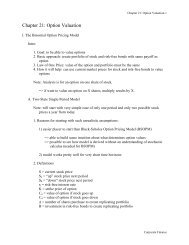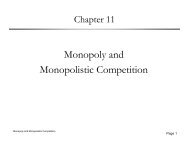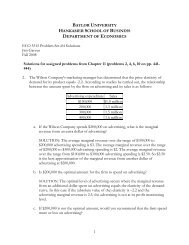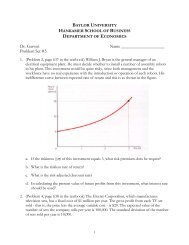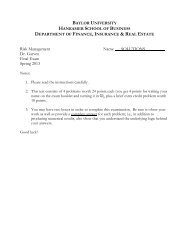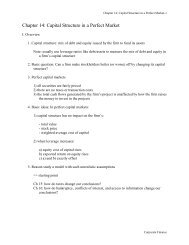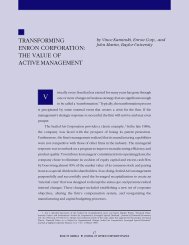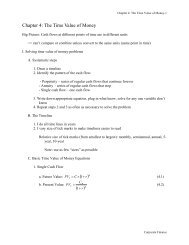Insurance Company Capital Structure Swaps and Shareholder Wealth
Insurance Company Capital Structure Swaps and Shareholder Wealth
Insurance Company Capital Structure Swaps and Shareholder Wealth
You also want an ePaper? Increase the reach of your titles
YUMPU automatically turns print PDFs into web optimized ePapers that Google loves.
sell $200 in new business <strong>and</strong> use the cash proceeds to retire equity. In either case, the capital<br />
structure has changed <strong>and</strong> shareholder wealth is impacted. Specifically, issuing equity <strong>and</strong> using<br />
proceeds to purchase reinsurance increases the wealth of the controlling shareholders, while issuing<br />
new policies <strong>and</strong> using proceeds to retire equity diminishes wealth. The manager’s objective is<br />
to maximize wealth for controlling shareholders (defined earlier as the pre-swap shareholders that<br />
still hold shares after the swap). Thus, the firm can increase the value of controlling shareholders’<br />
equity by issuing equity <strong>and</strong> using the proceeds to purchase reinsurance.<br />
6.3 Volatility Estimates Differ (Market Volatility Lower)<br />
We now reverse the relative valuations <strong>and</strong> show that when insurers are able to charge prices above<br />
expected loss, they can sell more policies <strong>and</strong> use the proceeds to retire equity, keeping assets<br />
constant. This might be particularly appealing to managers who wish to write a more risky line of<br />
business that also provides additional diversification benefits. As shown in table 3, when managers<br />
can sell higher-priced policies <strong>and</strong> use the proceeds to retire equity, controlling shareholders will<br />
gain wealth.<br />
6.4 Differences Regarding Both Expected Loss <strong>and</strong> Volatility (Market Lower)<br />
Until now, we have assumed that managers <strong>and</strong> investors differ only in their assumptions about<br />
volatility of losses. We now introduce another layer of uncertainty: the expected loss of the pol-<br />
icy portfolio. Managers have access to claim files <strong>and</strong> become aware of shifts in loss values <strong>and</strong><br />
probability estimates before investors <strong>and</strong> policyholders. As long as there is a set of uninformed<br />
noise traders, managers may be able to expropriate wealth from them to the benefit of controlling<br />
shareholders. Even if we assume that managers could not trade on this information without moving<br />
markets, there are other motivations for purchasing reinsurance when prices are high. In particular,<br />
the comparative advantages in real services offered by reinsurers <strong>and</strong> the decreased probability of<br />
financial distress costs may motivate reinsurance purchase, even when its price is above expected<br />
loss.<br />
For completeness, we also consider the swap that may be available when the insurer prices<br />
23



